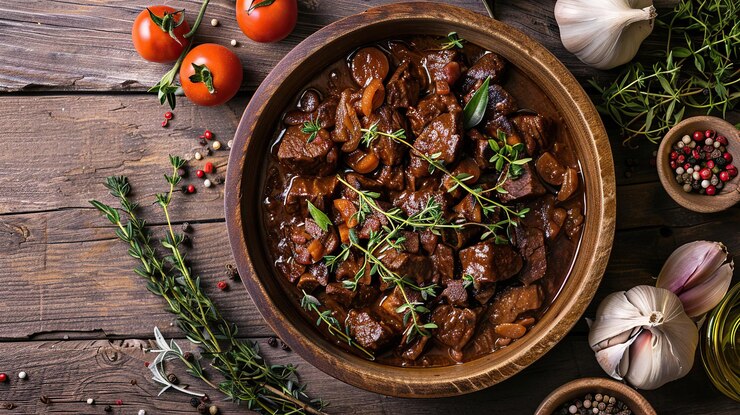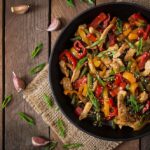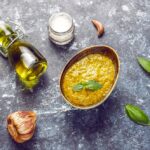Braising is one of the most flavorful and tenderizing cooking techniques, perfect for transforming tougher cuts of meat and hearty vegetables into rich, melt-in-your-mouth dishes. Whether you’re new to the kitchen or a seasoned cook, braising offers a simple yet effective way to create deep, complex flavors with minimal effort. Here’s everything you need to know about braising, including its definition, the best foods to braise, and a step-by-step guide to mastering the technique.
What is Braising?
Braising is a cooking method that involves cooking food slowly in a small amount of liquid over low heat. It’s a combination of two techniques: searing and simmering. First, the food is browned in fat (usually oil or butter) to develop flavor through the Maillard reaction, which creates a rich, brown crust. Then, the food is simmered gently in liquid (such as broth, wine, or water) until it becomes tender. The result is a dish that’s both juicy and flavorful, with the food absorbing the liquid’s seasonings and aromatics during the long, slow cooking process.
Why Braise?
The beauty of braising lies in its ability to make tough cuts of meat incredibly tender. When cooked slowly, the collagen in tougher meats breaks down into gelatin, creating a luscious, silky texture. Braising is also highly versatile, making it suitable for meats, vegetables, and even fruits. The slow cooking process allows for the infusion of deep flavors, making it a perfect technique for hearty, comforting meals.
The Best Foods to Braise
Certain cuts of meat and vegetables are ideal for braising. The foods that benefit most from braising are typically those that are tougher and contain more connective tissue, which breaks down beautifully with slow cooking. Here are some of the best options:
Meats:
- Beef: Cuts like chuck roast, short ribs, brisket, and oxtail are perfect for braising. The slow cooking process turns these cuts into tender, flavorful pieces of meat.
- Pork: Pork shoulder, pork belly, and country-style ribs are all great options. These cuts become juicy and tender when braised.
- Lamb: Lamb shanks or shoulder are ideal for braising, allowing the flavors to develop and the meat to become melt-in-your-mouth tender.
- Chicken: While chicken breasts can dry out with braising, dark meat such as thighs and legs benefit from the method. Chicken pieces braised in a flavorful liquid absorb the tastes of herbs, spices, and vegetables.
Vegetables:
- Root Vegetables: Carrots, parsnips, turnips, and potatoes are excellent for braising. They absorb flavors from the braising liquid and soften beautifully.
- Cabbage: Cabbage, particularly Savoy cabbage, can be braised with ham, bacon, or other meats for a flavorful dish.
- Squash: Winter squash varieties like butternut and acorn can be braised to enhance their natural sweetness.
The Braising Process: A Step-by-Step Guide
- Prepare the Ingredients: Begin by seasoning the meat or vegetables with salt and pepper. For meats, consider marinating beforehand for added flavor. If you’re braising vegetables, chop them into uniform pieces to ensure even cooking.
- Sear the Food: Heat a heavy pot (such as a Dutch oven) over medium-high heat and add oil. Once the oil is hot, brown the food in batches, ensuring each piece develops a deep, golden crust. This step is crucial for building flavor, so don’t rush it. Browning also creates fond (the flavorful bits left in the pan), which will be deglazed later to add even more depth to the dish.
- Deglaze the Pan: After searing the meat or vegetables, add a small amount of liquid to the hot pan—this could be broth, wine, or even water. Scrape up the fond with a wooden spoon, incorporating it into the liquid. This step helps capture all those rich, caramelized flavors.
- Add Aromatics and Liquid: Add aromatics such as onions, garlic, herbs, and spices to the pan. Stir them in, allowing them to release their flavors. Then, pour in enough liquid to come halfway up the sides of the meat or vegetables. The liquid doesn’t need to cover the food completely; it just needs to create steam and moisture for the braising process.
- Simmer Slowly: Bring the liquid to a simmer, then cover the pot with a tight-fitting lid. Reduce the heat to low and let the food braise slowly. This can take anywhere from 1.5 to 4 hours, depending on the cut of meat or vegetable being braised. You want the food to become tender but not fall apart completely.
- Finish and Serve: Once the braising process is complete, remove the food from the pot and let it rest. You can then reduce the braising liquid into a sauce by simmering it down to intensify the flavor. Pour the sauce over the meat or vegetables before serving.
Tips for Successful Braising
- Low and Slow: The key to braising is cooking over low heat for a long time. This allows the flavors to develop fully and gives the meat time to tenderize without becoming dry.
- Braising Liquid: While water can work, using broth, wine, or beer adds more flavor to the dish. You can also add a splash of vinegar or citrus juice to brighten the flavors.
- Choose the Right Pot: A heavy, thick-bottomed pot like a Dutch oven is ideal for braising because it retains heat well and distributes it evenly.
- Don’t Skip Searing: Searing the food at the start builds flavor, so don’t skip this step. It’s also important for creating the rich, brown color that adds visual appeal to your dish.
- Check for Tenderness: Braising is all about patience. If the food isn’t fork-tender after a few hours, continue cooking until it reaches the desired texture.
Popular Braised Dishes
- Beef Bourguignon: A classic French dish made by braising beef in red wine, broth, and vegetables.
- Osso Buco: A traditional Italian dish of braised veal shanks, cooked with tomatoes, white wine, and broth.
- Coq au Vin: A French dish where chicken is braised in red wine with mushrooms, onions, and herbs.
- Braised Pork Belly: Pork belly cooked slowly in a flavorful liquid until it’s tender and full of flavor.
Braising is a cooking method that rewards patience and time, transforming even the toughest cuts of meat into tender, flavorful meals. By following a simple process of searing, simmering, and slowly cooking in liquid, you can create dishes that are rich in flavor and satisfying in texture. Whether you’re braising meats, vegetables, or both, this technique is a valuable skill to have in your cooking repertoire, offering endless opportunities to create delicious, comforting meals.







